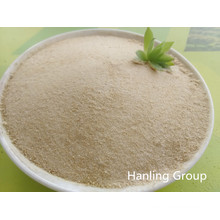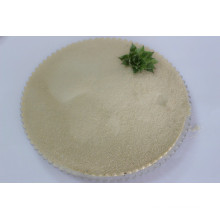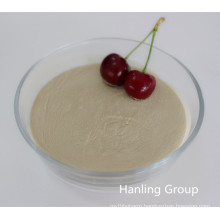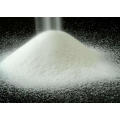Food Grade Lactose Powder with CAS 63-42-3
Lactose is a disaccharide naturally present in mammalian milk. Secreted by the mammary glands of mammals, only in the animal kingdom. Molecular formula C12H22O11. It is a disaccharide composed of glucose and galactose, which is obtained by dehydration of a hydroxyl group on the fourth carbon atom of glucose with a β-hemiacetal hydroxyl group of the first carbon atom of galactose. Therefore, the reducibility of the aldehyde group contained on the glucose molecule is maintained. There are two isomers of α-form and β-form. 5Gram. The crystallized from the mother liquor, the amount of crystallized water, a melting point of 202 ° C, a specific optical rotation of +88 °, solubility of 7.4 g. Crystallized above 93.5 ° C is β-type lactose, melting point 252 ° C, specific optical rotation +34 °, solubility 55 g, no crystal water in the molecule. Alpha-type sugars have low hygroscopicity and do not absorb external moisture in a high humidity environment, which is extremely important for controlling water activity in foods.
Feature:
High Purity
Low Price
Fast delivey
Good service
Lactose Product details:
English name: Lactose
English synonyms: Aletobiose; Galactinum; lactose, anhydrous; Osmolactan; Saccharum lactin; saccharumlactin; LACTOBIOSE; LACTIN
CAS No.: 63-42-3
Molecular formula: C12H22O11
Molecular weight: 342.3
EINECS number: 200-559-2
Melting point 222.8°C
Boiling point 397.76 ° C (rough estimate)
Density 1.5300
Refractive index 1.5376 (estimate)
Form Powder
Color White to Off-white
Lactose Application:
Nutritional sweetener; excipient; dispersing agent; flavoring agent; nutrient. Mainly used:
As an adsorption dispersant for powdery food coloring, the pigment concentration is lowered, which is convenient to use and reduces discoloration during storage.
It is characterized by easy compression molding and low water absorption, and is used as an excipient for tableting.
With the low caramelization temperature of lactose (sucrose 163 ° C, glucose 154.5 ° C, lactose only 129.5 ° C), for some special baked goods, deep yellow to caramel color can be obtained at lower baking temperature .
Others have the effects of preventing crystallization, reducing sweetness, preventing sticking and enhancing fragrance.
Used in baby food, candy and margarine.
Lactose Attention:
[Ingestion]
If victim is conscious and alert, give 2-4 cupfuls of milk or water. Never give anything by mouth to an unconscious person. Get medical aid immediately.
[Inhalation]
Get medical aid immediately. Remove from exposure to fresh air immediately. If not breathing, give artificial respiration. If breathing is difficult, give oxygen.
[Skin]
Get medical aid immediately. Flush skin with plenty of soap and water for at least 15 minutes while removing contaminated clothing and shoes. Wash clothing before reuse.
[Eyes]
Flush eyes with plenty of water for at least 15 minutes, occasionally lifting the upper and lower eyelids. Get medical aid immediately.
Storage: Store in a tightly closed container. Do not store in glass. Store in a cool, dry area away from incompatible substances.
Package: 25kg/bag
Other related items of our company:
1. Basic Organic Chemicals
2. Inorganic Chemicals
4. Daily Chemicals
5. Active Pharmaceutical Ingredients
Food Grade Maltose with CAS 69-79-4
Lactose is a disaccharide linked by a molecule of beta-D-galactose and a molecule of beta-D-glucose at the beta-1,4-position to form glycosidic bonds. Molecular formula C12H22O11 (Jmol stereogram), molar mass 342.3 grams. There are two kinds of end group isomers: alpha lactose and beta lactose, which can be transformed into each other in aqueous solution. Alpha lactose readily combines with one molecule of crystalline water. Sweetness is about 1/5 of sucrose, and the solid component of 2-8% in milk is lactose. The intestinal tract of young mammals secretes lactase and decomposes lactose to monosaccharide. Adult animals, including most Caucasians, have significantly reduced lactase activity. Therefore, drinking milk can produce diarrhea, abdominal distension and other symptoms, known as lactose intolerance. Adult animals can also stimulate the activity of lactase in the intestinal tract and increase a certain amount if they continue to drink dairy products for a long time (a small amount of slow drinking is preferable in the early stage). Although the activity and quantity of lactase are not as good as those in early childhood, it can still help to decompose lactose effectively.
Maltose is the abbreviation of maltodose, also known as D-maltose, sucrose. The sugar is less distributed in nature and is mostly present in germinated malt. Further decomposition of one molecule of maltose yields two molecules of glucose. The sweetness of maltose is about half of that of sucrose, but it tastes refreshing and does not stimulate the gastric mucosa. It is one of the most nutritious sugars. Maltose is widely used in various fields of the food industry, such as solid foods, liquid foods, frozen foods, and colloidal foods (if frozen). Maltose syrup is not only a sweetener in food, but also an additive, a preservative, and a moisturizer.
Food Grade Maltose
Feature:
High Purity
Low Price
Fast delivey
Good service
Maltose Product details:
English name: Maltose
English synonym: 4-(alpha-D-Glucopyranosido)-alpha-glucopyranose; 4-(alpha-D-Glucosido)-D-glucose; 4-o-alpha-d-glucopyranosyl-d-glucos; 4-O-Hexopyranosylhexose ;alpha-Malt sugar;alpha-maltsugar;Cextromaltose;Maltos
CAS No: 69-79-4
Molecular formula: C12H22O11
Molecular weight: 342.3
EINECS number: 200-716-5
Melting point 110 °C
Boiling point 397.76 ° C (rough estimate)
Density 1.5400
Refractive index n20/D 1.361
PH value 4.0-6.5 (25°C)
Maltose Application:
1. Food field
Maltose is widely used in various fields of the food industry, such as solid foods, liquid foods, frozen foods, and colloidal foods (if frozen).
Maltose syrup is not only a sweetener in food, but also an additive, a preservative, and a moisturizer. Maltose syrup contains a large amount of dextrin, has good crystallinity resistance, does not precipitate crystals in frozen foods, and prevents the crystallization of other sugars, so that crystallization of sucrose can be prevented during the production of jams and jellies. Extend the shelf life of the food. Maltose syrup has good fermentability and is therefore widely used in the manufacture of bread, cakes and beer. Maltose syrup has the effect of preventing starch from condensing and aging, and can increase the shelf life of canned jelly, jam and starched cans. Maltose syrup has low sweetness, low hygroscopicity and high moisture retention. Maltose with one molecule of crystal water is very stable, which increases the moisture retention of food. Adding maltose syrup to the pastry can make the pastry fresh and delicious, but when the maltose absorbs 6%-12% of water, it will no longer absorb water and will not release water. This property can make the food dehydrate and prevent food. The aging makes the food soft, moist, fresh and delicious for a long time, and increases the shelf life of the food.
Maltose is relatively stable to acid and heat. It does not decompose when heated at pH 3 and 120 °C for 90 min. The temperature of the sugar can reach 160 °C. It is not easy to change the Merat reaction when heated, so it will not be maltose at normal temperature. Decomposition causes food to deteriorate and taste. High maltose syrup can replace acid-hydrolyzed starch syrup in the candy industry. Not only the product tastes mild, the sweetness is moderate, the product is not easy to change color, and the hard candy has good transparency and good sand resistance and stagnation resistance, thus prolonging preservation. period. High maltose syrup contains less protein, Amino Acid and other substances that can react with melamine in carbohydrates, so it has good thermal stability. It is more suitable for vacuum film method, tantalum sugar and casting than candy. . Currently, the main use of high maltose syrup in the food industry is in the manufacture of confectionery and jellies, cakes, beverages and the like. Studies have shown that the utilization of high maltose syrup is developing in two aspects: one is to prepare ultra-high maltose syrup having a solid content of 80% without crystallization under normal storage conditions; the other is to produce pure maltose.
2. Medical field
When the vein is injected into the vein with pure maltose, the blood sugar will not rise, which is suitable for diabetics to supplement nutrition. Maltose can be absorbed without metabolism in human metabolism. It is a nutrient and auxiliary therapeutic agent for diabetic patients, and a sweetener for health foods and functional foods for diabetic patients. Maltose is also a raw material for the manufacture of maltulose and oligo-isoma malt candy. The latter two promote the reproduction of beneficial human Bifidobacterium lactobacilli in the intestine and are very good functional foods. Therefore, maltose is unique in medicine. effect.
3. Maltose biosynthesis trehalose
Trehalose is a non-reducing disaccharide linked by two molecules of glucose through α-1,1 glycosidic bonds, which has non-specific protective effects on organisms and biomacromolecules.
Maltose Attention:
[Ingestion]
If victim is conscious and alert, give 2-4 cupfuls of milk or water. Never give anything by mouth to an unconscious person. Get medical aid immediately.
[Inhalation]
Get medical aid immediately. Remove from exposure to fresh air immediately. If not breathing, give artificial respiration. If breathing is difficult, give oxygen.
[Skin]
Get medical aid immediately. Flush skin with plenty of soap and water for at least 15 minutes while removing contaminated clothing and shoes. Wash clothing before reuse.
[Eyes]
Flush eyes with plenty of water for at least 15 minutes, occasionally lifting the upper and lower eyelids. Get medical aid immediately.
Storage: Store in a tightly closed container. Do not store in glass. Store in a cool, dry area away from incompatible substances.
Package: 25kg/bag
Contact us if you need more details on Food Grade Lactose Powder CAS 63-42-3. We are ready to answer your questions on packaging, logistics, certification or any other aspects about CAS NO 63-42-3、Food Grade CAS 63-42-3. If these products fail to match your need, please contact us and we would like to provide relevant information.
Product Categories : Additives > Food Additive





